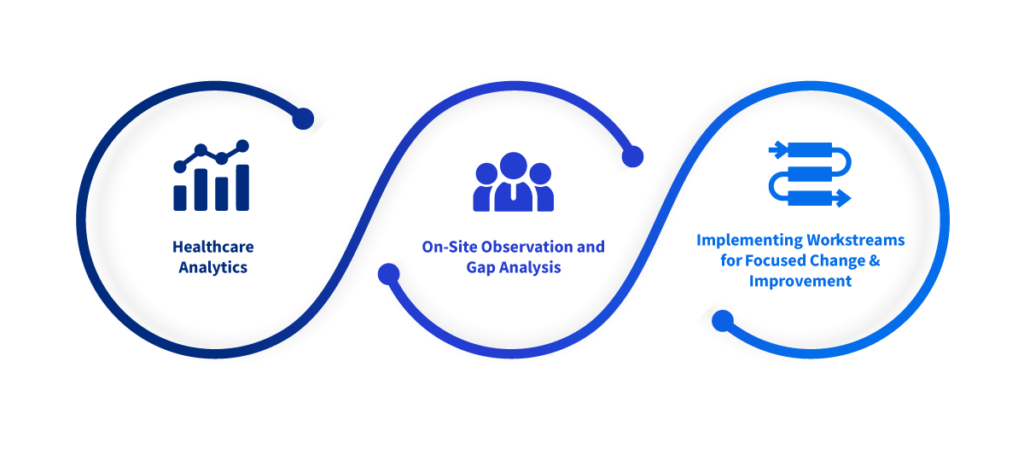Medicare Star ratings matter.
CMS widely publicizes Medicare Star ratings, encouraging consumers to use the organization’s Compare website to help choose where to receive care.
Likewise, hospitals, especially ones with four- and five-star ratings, highlight their performance in marketing and PR efforts.

As Ovation Healthcare’s CEO Dwayne Gunter shared in a recent blog, Wooster Community Hospital (WCH) is one of the very best hospitals in the world. For nearly 30 years, Ovation Healthcare has worked closely with the leaders and board of directors of WCH, helping them with strategy, supply chain and much more.
To say Wooster is an award-winning hospital is a big understatement. In just the first six months of 2022, Wooster received 10 awards, including Newsweek’s Best Hospitals in the World 2022, and a 5-star CMS rating.
In contrast to health plans, Star ratings for hospitals are not directly tied to financial reimbursement but “many of the measures used to determine the overall star ratings are also used in other programs, such as the Hospital Value-Based Purchasing Program, that do directly affect reimbursement.”
Medicare Star Ratings: The Methodology
In July, Medicare released the 2022 Overall Star Ratings. The majority of hospitals received three or four stars.

The 2022 Overall Star Rating selects 47 of the more than 100 measures CMS publicly reports on Care Compare and divides them into five measure groups:
Mortality:
Seven measures, e.g., death rate for heart attack, heart failure, stroke and pneumonia patients.

Safety of Care:
Eight measures, e.g., surgical site infections from colon surgery and abdominal hysterectomy.

Readmission:
Eleven measures, e.g., rate of unplanned hospital visits for patients receiving outpatient chemotherapy or outpatient chemotherapy.

Patient Experience:
Eight measures, e.g., patients who reported that their doctors and nurses communicated well and that staff explained about medicines before giving it to them.

Timely & Effective Care:
Thirteen measures, e.g., the percentage of patients who received appropriate care for severe sepsis and septic shock and the percentage who left the emergency department before being seen.

Mortality, Safety, Readmission and Patient Experience were weighted at 22 percent and Timely & Effective Care at 12 percent.
In my last blog, I introduced Ovation Healthcare’s Clinical Solutions team. Led by Dr. Kristine Keefer-Wolff, Senior Vice President, Clinical Solutions, this team has more than 300 years of expertise in hospital and health system quality and patient safety and a growing list of client success stories.
Two of my favorite client success stories from the Clinical Solutions team are:
How to Increase Your Hospital’s Medicare Star Rating
The Clinical Solutions team are the ones who partner with hospitals to increase their Medicare Star rating. Our approach to improving star ratings starts with analytics and moves through organizational workstreams that impact performance. Ovation Healthcare’s 3-step methodology includes:

Healthcare Analytics
1. Data collected and processed from the stars analytic period and from a hospital’s most current data.
- Identify all CMS source data files that are used to create the star ratings, the time period the data is from and when it will be updated
2. Create an analytic scorecard template to evaluate current performance across star rating categories to benchmark.
3. Collaborate with the clinical team to prioritize departmental analysis to be completed during onsite observation.
4. Establish a database to capture monthly client data and update performance monthly.
5. Develop a predictive analytic engine to predict future star rating based on performance improvement.
- Data reviewed, compiled and weighted with a focus on the summary score of the weighted average of the hospital’s scores for each measure group or category: Mortality, Safety of Care, Readmission, Patient Experience and Timely & Effective Care. The measures in the five categories include quality measures for both inpatient and outpatient care, many of which are also included in the CMS Hospital Value-Based Purchasing Program, Hospital Readmission Reduction Program, the Hospital Acquired Conditions Reduction Program, Hospital Outpatient Program and even Leapfrog grades. As we seek to improve the Overall CMS Star Ratings, we at Ovation Healthcare are very aware of the cross functional impact on these other programs
Onsite Observation and Gap Analysis
1. Ovation Healthcare uses the above analytics as well as processes, minutes, organization charts and more to do a short, but powerful, onsite review of operations and workflows around critical areas that impact the following five domains:
- 1. Mortality
- 2. Safety of Care
- 3. Readmissions
- 4. Patient Experience
- 5. Timely & Effective Care
Workstreams for Focused Change and Improvement
1. Following the onsite review and gap analysis, Ovation Healthcare will:
- Create an appropriately sequenced roadmap for change and improvement
- Build our recommendations on a patient-centered foundation
2. Prioritize measures to focus on and set specific, performance targets that can be monitored to achieve goals.
3. Provide implementation support to accelerate an organization’s star improvement journey with performance improvement strategies that focus on goal sustainability.



